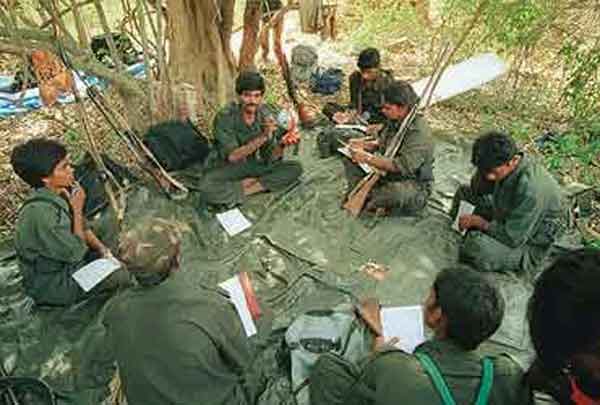In 2010, then Home Minister PC Chidambaram had announced that the Maoist problem will be over in next 2-3 years. Coming from the Union Home Minister that Maoist insurgency will be over by 2013-2014, it should have called for celebrations. Eight years have passed since that announcement but the recently released US State Department annual report by the National Consortium for the Study of Terrorism and Response to Terrorism (START) pertaining to year 2017 states that India ranks third globally in the number of deaths due to terror attacks with a total of 860 deaths due to terrorism (Iraq first with 1951 deaths and Afghanistan second with 1171 deaths); 8,584 terrorist attacks worldwide in 2017 resulting in total of 18,700 deaths. The shocking revelation was that the Communist Party of India (Maoist) was ranked as the 4th deadliest terror organization in the world with a total of 295 attacks causing 206 deaths, 212 injuries and 125 kidnappings – ranked even deadlier than the Boko Haram.
There is no doubt the Modi Government has been focused on addressing the Maoist insurgency, even as in March-April 2017 alone, CRPF had lost 37 of its men to Maoists, losing 29 assault rifles, four LMGs, one 51mm mortar, one UBGL, seven two radio sets and assorted ammunition. Home Minister Rajnath Singh has been stressing need for smart leadership, aggressive strategy, motivation and training, actionable intelligence, dashboard-based KPIs (key performance indicators) and KRAs (key result areas), harnessing technology, action plan for each theatre and denial of financing to terrorists, besides good leadership and unified coordination and command.
Under government’s counter-Maoist policy, a National Action Plan comprising security, development and ensuring rights and entitlements of local communities, included: construction of fortified police stations in Maoist-hit areas; road construction in most difficult areas in phased manner; erection of mobile towers for improving telephone connectivity in remote areas; opening of banks, ATMs and post offices in Maoist affected states; security related expenditure (SRE) scheme, special infrastructure scheme (SIS), integrated action plan (IAP) and few other schemes to be extended for a few more years subject to Finance Ministry approval.
Terrorist incidents have continued in 2018. Security forces have had some successes and there have been some well publicized surrender as well. There have also been reports of some Maoists getting fed up with the hardcore etc but without doubt it is going to be a very haul. Pahad Singh, a senior Maoist leader carrying reward of Rs 47 lakh on his head surrendered recently to the police in Chhattisgarh. He was the Special Zone Committee (SZC) member of Maoists and was active in Maharashtra, Chhattisgarh and Madhya Pradesh since 2000. He reportedly told the police that senior Maoist leaders often harass local leaders in the party and constant suspicion and harassment of local Chhattisgarh cadres by Maoists leaders from Maharashtra and Andhra Pradesh made him lose faith in the Maoists ideology – he himself belonging to Chhattisgarh. The DGP of Jharkhand made a statement in January 2018 that Maoists will be finished in Jharkhand in 2018 itself which appears more of a political statement. On September 24, 2018, Maoists shot dead two TDP MLAs in Andhra Pradesh, which had been without incident past four years.
If just a comparative tally is taken of the assault rifles, LMGs and mortars that the Maoists have been able to take from the security forces over the years vis-à-vis what security forces have recovered from Maoists (many antiquated) it would indicate considerable Maoists armoury is largely intact, and this not counting weapons pumped in from abroad and illegal production of AK-47 rifles in Bihar. Pakistan’s ISI-SIMI-Maoist nexus merits serious concern, as does ISI involvement. In 2005, empties of bullets fired by Maoists were found with Pakistan Ordnance Factory (POF) markings. IB reported in that in 2008, 500 Maoists had undergone training under SIMI in Kerala. In 2009-2010, Stratfor had warned ISI forging alliance with Maoists. Under aegis of ISI, a core group of Maoists were imparted training in mines, IEDs and explosives by the LTTE. Reports in November, 2010 indicated Maoists had acquired a vast and assortment of foreign weapons, including rifles of .315 bore to .30-06 calibre and that more than three quarters of their US$70,000 budget was spent on procuring weapons and armaments – about US$ 20,604.
The server hosting Maoists propaganda website is located in China. To mask its location, administrators of the website, in connivance server operators, have tried to make it appear as if the server is hosted in Canada, by using a proxy server. China has been supporting and arming Maoists through the northeast. Nepalese Maoists have openly pledged full support to Maoists in India. With Nepal having gone into the Chinese orbit, we should expect much more support coming in terms of weapons and finances. Domination of the 72,000 sq km Dandakaranya Forest is a complex issue but at the root lies India’s inability to manage social change, rampant corruption, economic disparities, social inequities and restoring tribal rights with regard to forested areas though guaranteed by the Constitution.
In West Bengal during 1960s, the fight actually began for land rights, as was seen in the later years in Andhra Pradesh. The tribal movements joined in from Chhattisgarh and Jharkhand as did the caste conflicts in the states of Bihar and Jharkhand. Hence, Maoists are expanding their influence by picking up issues that are troubling the local population. They have large base of sympathizers in urban areas. The Government has recently arrested some over ground ‘Urban Maoists’, in whose case investigations are still continuing with Maharshtra Police claiming considerable evidence. But why the Maoists insurgency will indeed be a long haul has been succinctly brought out by former Foreign Secretary Shyam Saran in his recent article titled ‘The price of ‘national security’, wherein he wrote: “Security forces are deployed to defeat left-wing extremism, yet its economic and social dimensions are ignored. Without acknowledging this, it is difficult to see how the Naxal challenge can be met, whether in its rural or urban manifestation. Detaining social activists who raise such uncomfortable questions about the State’s misgovernance and its pursuit of discriminatory policies against the most underprivileged citizens of our country is not going to promote national security”.
The important thing is also to acknowledge that what is being referred to as Maoist insurgency, has become a flourishing industry, the estimates of annual extortion earnings alone estimated to be to the tune of Rs 1500-2000 crore. It is an industry in which all segments including the polity, administration, corporate, mining barons, timber merchants and everyone else benefit. The security forces can only deal with violence levels, while the inertia of corruption, criminality and misgovernance are churning at the other end. The external and internal enemies are more than happy to exploit this tailor-made asymmetrical battlefield. Whether as a nation the Centre and the States are resolved to finish insurgencies or not, readers can decide. But one thing is pretty certain – the Maoist issue will likely continue for many years to follow.





